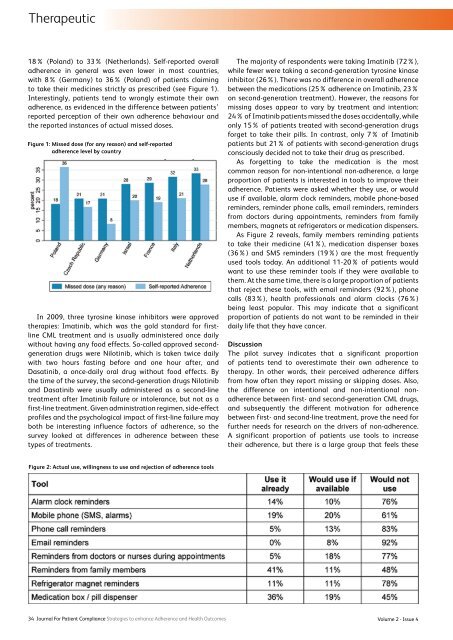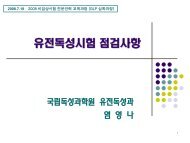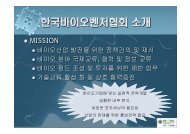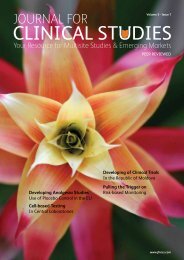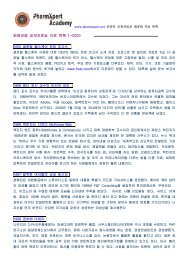Therapeutic18% (Poland) to 33% (Netherlands). Self-reported overalladherence in general was even lower in most countries,with 8% (Germany) to 36% (Poland) of patients claimingto take their medicines strictly as prescribed (see Figure 1).Interestingly, patients tend to wrongly estimate their ownadherence, as evidenced in the difference between patients’reported perception of their own adherence behaviour andthe reported instances of actual missed doses.Figure 1: Missed dose (for any reason) and self-reportedadherence level by countryIn 2009, three tyrosine kinase inhibitors were approvedtherapies: Imatinib, which was the gold standard for firstlineCML treatment and is usually administered once dailywithout having any food effects. So-called approved secondgenerationdrugs were Nilotinib, which is taken twice dailywith two hours fasting before and one hour after, andDasatinib, a once-daily oral drug without food effects. Bythe time of the survey, the second-generation drugs Nilotiniband Dasatinib were usually administered as a second-linetreatment after Imatinib failure or intolerance, but not as afirst-line treatment. Given administration regimen, side-effectprofiles and the psychological impact of first-line failure mayboth be interesting influence factors of adherence, so thesurvey looked at differences in adherence between thesetypes of treatments.The majority of respondents were taking Imatinib (72%),while fewer were taking a second-generation tyrosine kinaseinhibitor (26%). There was no difference in overall adherencebetween the medications (25% adherence on Imatinib, 23%on second-generation treatment). However, the reasons formissing doses appear to vary by treatment and intention:24% of Imatinib patients missed the doses accidentally, whileonly 15% of patients treated with second-generation drugsforget to take their pills. In contrast, only 7% of Imatinibpatients but 21% of patients with second-generation drugsconsciously decided not to take their drug as prescribed.As forgetting to take the medication is the mostcommon reason for non-intentional non-adherence, a largeproportion of patients is interested in tools to improve theiradherence. Patients were asked whether they use, or woulduse if available, alarm clock reminders, mobile phone-basedreminders, reminder phone calls, email reminders, remindersfrom doctors during appointments, reminders from familymembers, magnets at refrigerators or medication dispensers.As Figure 2 reveals, family members reminding patientsto take their medicine (41%), medication dispenser boxes(36%) and SMS reminders (19%) are the most frequentlyused tools today. An additional 11-20% of patients wouldwant to use these reminder tools if they were available tothem. At the same time, there is a large proportion of patientsthat reject these tools, with email reminders (92%), phonecalls (83%), health professionals and alarm clocks (76%)being least popular. This may indicate that a significantproportion of patients do not want to be reminded in theirdaily life that they have cancer.DiscussionThe pilot survey indicates that a significant proportionof patients tend to overestimate their own adherence totherapy. In other words, their perceived adherence differsfrom how often they report missing or skipping doses. Also,the difference on intentional and non-intentional nonadherencebetween first- and second-generation CML drugs,and subsequently the different motivation for adherencebetween first- and second-line treatment, prove the need forfurther needs for research on the drivers of non-adherence.A significant proportion of patients use tools to increasetheir adherence, but there is a large group that feels theseFigure 2: Actual use, willingness to use and rejection of adherence tools34 Journal For Patient Compliance Strategies to enhance Adherence and Health OutcomesVolume 2 - Issue 4
Therapeutictools are not yet available to them. However, there is nosingle adherence tool for everyone, which is demonstratedby a large rejection rate of all tools in some groups. A morestatistically significant survey may provide insights into whichtools might work best for certain subpopulations within thepatient community.Overall, the pilot survey has strengthened our thinkingthat there are certain country-specific characteristics, druganddisease-phase-related factors, as well as different driversand tools influencing intentional and non-intentional nonadherence.The next phase of this research work, run by a workgroupof eight European CML patient advocates and two CMLexperts from European countries, is currently underway. Thesurvey is conducted online and offline and intends to haveat least 2000 respondents. The questionnaire was deployedon 22 September 2012 in 12 languages (English, Spanish,German, French, Italian, Portuguese, Finnish, Dutch, Czech,Hebrew, Polish and Russian), with more than 1600 patientsfrom 73 countries having responded in the first eight weeks.To minimise the online recruitment bias, clinicians in threenational CML research groups - GIMEMA in Italy, FI LMC inFrance and the German CML Study Group - are cooperatingwith the CML Advocates Network to distribute hard-copyquestionnaires to CML patients in addition to the onlinesurvey. Results of the study are expected to become availablein spring 2013.ReferencesAerts E, Kellerhals SD, Fliedner M (2011): Adherence to oralanti-tumour therapies. EBMT Swiss Nurses GroupBreccia M, Efficace F, Alimena G (2011): Imatinib treatment inchronic myelogenous leukemia: What have we learned so far?Cancer Lett 300(2): 115–121Efficace F, Baccarani M, Rosti G, Cottone F, Castagnetti F, BrecciaM, Alimena G, Iurlo A, Rossi AR, Pardini S, Gherlinzoni F, SalvucciM, Tiribelli M, Vignetti M, Mandelli F (2012): Investigatingfactors associated with adherence behavior in patients withchronic myeloid leukemia: an observational patient-centeredoutcome study. British Journal of Cancer: 2012.348Eliasson L, Clifford S, Barber N, Marin D (2011): Exploringchronic myeloid leukemia patients’ reasons for not adhering tothe oral anticancer drug imatinib as prescribed. Leuk Res 35:626–630Marin D, Bazeos A, Mahon FX, Eliasson L, Milojkovic D, BuaM, Apperley JF, Szydlo R, Desai R, Kozlowski K, Paliompeis C,Latham V, Foroni L, Molimard M, Reid A, Rezvani K, de LavalladeH, Guallar C, Goldman J, Khorashad JS (2010): Adherence is thecritical factor for achieving molecular responses in patients withchronic myeloid leukemia who achieve complete cytogeneticresponses on imatinib. J Clin Oncol 28: 2381–2388Noens L, van Lierde MA, De Bock R, Verhoef G, Zachee P,Berneman Z, Martiat P, Mineur P, Van Eygen K, MacDonaldK, De Geest S, Albrecht T, Abraham I (2009): Prevalence,determinants, and outcomes of nonadherence to imatinibtherapy in patients with chronic myeloid leukemia: the ADAGIOstudy. Blood 113: 5401–5411Ruddy K, Mayer E, Partridge A (2009): Patient adherence andpersistence with oral anticancer treatment. CA Cancer J Clin 59:56–6AcknowledgementsThe pilot survey on CML Adherence was developed and run by aworkgroup of the following CML patients and experts:• Giora Sharf, Chair of the Adherence Workgroup / CMLAdvocates Network / Leukemia Patient Advocates Foundation,Switzerland / Israeli CML Patients Organisation• Jan Geissler, CML Advocates Network / Leukemia PatientAdvocates Foundation, Switzerland / LeukaNET, Germany• Felice Bombaci, Gruppo AIL Pazienti Leucemia MieloideCronica (Italy)• Mina Daban, President, Leucémie Myéloide Chronique France(France)• Anna Span, Editor LeukoNiews, Stichting ContactgroepLeukemie (Netherlands)• Audrey Denis, Secretary, Vivre Avec La LMC (France)• Tony Gavin, Director of Campaigning and Advocacy,Leukaemia CARE (UK)• Dr Lina Eliasson, Research Associate, Centre for Haematology,Division of Experimental Medicine, Imperial College London(UK)• Dr Fabio Efficace, Chairman GIMEMA Working Party onQuality of Life (Italy)• Dr Joëlle Guilhot, Biostatistics, INSERM CIC 802, UniversityHospital of Poitiers (France)The workgroup received in-kind logistical support from Bristol-Myers Squibb.Jan Geissler is co-founder of the globalCML Advocates Network, co-founderand vice president of the LeukemiaPatient Advocates Foundation, andchair of Leukaemie-Online in Germany.He is Director of the European Patients’<strong>Academy</strong> on Therapeutic Innovation,and is acting as a patients’ representative in various steeringcommittees and advisory boards.Email: jan@cmladvocates.netGiora Sharf is co-founder of the globalCML Advocates Network, co-founderand treasurer of the Leukemia PatientAdvocates Foundation, and chair of theIsraeli CML Patients Organization. Email:giora@cmladvocates.netThe patient-run CML Advocates Network connects 68leukemia patient organisations in 55 countries on allcontinents. The network facilitates the sharing of bestpractice in CML patient advocacy, organizes an annualGlobal CML Advocacy Summit, and collaborates withresearchers and clinicians.www.JforPC.comJournal For Patient Compliance Strategies to enhance Adherence and Health Outcomes 35


